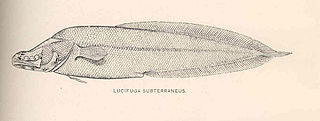
Ophichthidae is a family of fish in the order Anguilliformes, commonly known as the snake eels. The term "Ophichthidae" comes from Greek ophis ("serpent") and ichthys ("fish"). Snake eels are also burrowing eels, they are named for their physical appearance, they have long, cylindrical snakelike bodies. This family is found worldwide in tropical to warm temperate waters. They inhabit a wide range of habitats, from coastal shallows and even rivers, to depths of above 800 m (2,600 ft). Most species are bottom dwellers, hiding in mud or sand to capture their prey of crustaceans and small fish, but some are pelagic.

Lucifuga is a genus of viviparous brotulas. Most of the species are native to caves and sinkholes in Cuba and the Bahamas; L. inopinata from deep water off the Galápagos Islands is the only exception. The four species rated by the IUCN are all considered vulnerable. The largest species in the genus reaches about 15 cm (5.9 in) in length.

Ogilbia is a genus of viviparous brotulas. The generic name honours the Australian naturalist James Douglas Ogilby (1853-1925), for his contribution to the knowledge of the fishes of Australia.
Parasaccogaster melanomycter is a species of viviparous brotula endemic to Colombia.

Saccogaster is a genus of viviparous brotulas. They are found in the western Atlantic and Indo-Pacific.
Dermatopsis is a genus of viviparous brotulas.
Diancistrus is a genus of viviparous brotulas.
Gunterichthys is a genus of viviparous brotula.
Microbrotula is a genus of viviparous brotulas.
Ogilbichthys is a genus of viviparous brotulas found in the central-western Atlantic Ocean and the Caribbean Sea. he generic name refers to the resemblance of these fish to those in the genus Ogilbia, a name honours the Australian naturalist James Douglas Ogilby (1853-1925), combined with ichthys which means "fish" in Greek.
Paradiancistrus is a genus of viviparous brotulas.
Tuamotuichthys is a genus of viviparous brotulas found in the Pacific Ocean.

Sirembo is a genus of cusk-eels of the subfamily Neobythitinae, family Ophidiidae, which are found in the Indian and Pacific Oceans. The species in this genus have a rather robust body with the dorsal fin originating over vertebrae 1–5. The head and bod are completely covered in scales, they have large eyes which are almost equal in diameter to the length of snout, the pelvic fins have two rays which are joined together within an area of tough skin, They have a short spine on the operculum which does not extend to the posterior edge of the head. Their coloration is variable but almost all species have black spots or eyespots on the dorsal fin, sometimes both, while the middle part of the anal fin frequently has a black band. The body and/or head are marked with diagonal or horizontal dark stripes or horizontal rows of quite large dusky spots.
Spottobrotula is a genus of cusk-eels.
Kopua is a genus of clingfishes found in the Pacific Ocean.
Parasaccogaster is a genus of viviparous brotulas.
Bidenichthys beeblebroxi is a species of common reef fish of the Bythitidae family, and one of three species in the genus Bidenichthys. The species is found in the coastal waters off North Island and northern South Island, New Zealand. It is a common, uniformly gray-brown fish, ranging from SL 6.5–9.5 centimetres long in one study, found in holes beneath rocks and boulders in kelp forest and other reef habitats from the surface down to depths of 30 metres (98 ft). The species was described by Paulin in 1995.
Chauligenion camelopardalis, also known as the Giraffe-spotted snake eel, is a species of fish in the family Ophichthidae found in the Pacific Ocean. This species occurs at the west of Okinawa in the East China Sea. This species is the only known member of its genus.

Bythitinae is a subfamily of viviparous brotulas, one of the two subfamilies in the family Bythitidae. This subfamily is characterised by having the dorsal, caudal and anal fins combined. They are mostly found in temperate to tropical seas, from reefs to the benthopelagic zone, but some species from the North Atlantic Ocean occur in into Arctic waters.






